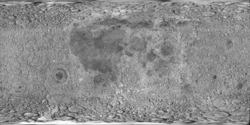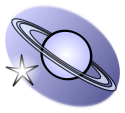Al-Bakri (månkrater)
| Månkrater | ||
|---|---|---|
| Al-Bakri | ||
 | ||
| Egenskaper | ||
| Latitud Longitud | ||
| Medeldiameter | 12.2 km | |
| Djup | 1 km | |
| Kolongitud | 340° vid soluppgång | |
| Eponym | Abu Abdullah al-Bakri | |
| Kartposition | ||
| Månen - Selenografi - ( ) | ||
Hitta fler artiklar om Astronomi med Astronomiportalen | ||
Al-Bakri är en nedslagskrater på månen som ligger vid den nordvästra gränsen till Mare Tranquillitatis. Den ligger strax söder om den östra armen av Montes Haemus som gränsar till Mare Serenitatis i norr. Till öst-nordöst är den framträdande kratern Plinius. Söder om kratern går de långa djupa kanalerna från Rimae Maclear. [1][2] Kratern har fått sitt namn av den andalusiske geografen och historikern Abu Abdullah al-Bakri (1010-1094).
Kraterns position är 14,3o N och 29,2o O.[3]
Al-Bakri kallades tidigare Tacquet A innan den döptes om av IAU. Den lilla kratern Tacquet ligger till nordväst på Mare Serenitatis.
Se även
Källor
• Andersson, L. E.; Whitaker, E. A. (1982). NASA Catalogue of Lunar Nomenclature. NASA RP-1097. • Bussey, B.; Spudis, P. (2004). The Clementine Atlas of the Moon. New York: Cambridge University Press. ISBN 978-0-521-81528-4. • Cocks, Elijah E.; Cocks, Josiah C. (1995). Who's Who on the Moon: A Biographical Dictionary of Lunar Nomenclature. Tudor Publishers. ISBN 978-0-936389-27-1. • Menzel, D. H.; Minnaert, M.; Levin, B.; Dollfus, A.; Bell, B. (1971). "Report on Lunar Nomenclature by the Working Group of Commission 17 of the IAU". Space Science Reviews 12 (2): 136–186. Bibcode:1971SSRv...12..136M. doi:10.1007/BF00171763. edit • Moore, Patrick (2001). On the Moon. Sterling Publishing Co. ISBN 978-0-304-35469-6. • Price, Fred W. (1988). The Moon Observer's Handbook. Cambridge University Press. ISBN 978-0-521-33500-3. • Rükl, Antonín (1990). Atlas of the Moon. Kalmbach Books. ISBN 978-0-913135-17-4. • Webb, Rev. T. W. (1962). Celestial Objects for Common Telescopes (6th revision ed.). Dover. ISBN 978-0-486-20917-3. • Whitaker, Ewen A. (1999). Mapping and Naming the Moon. Cambridge University Press. ISBN 978-0-521-62248-6. • Wlasuk, Peter T. (2000). Observing the Moon. Springer. ISBN 978-1-85233-193-1.
- Artikeln är, helt eller delvis, en översättning från engelskspråkiga Wikipedia.
- ^ Blue, Jennifer (2007). ”Gazetteer of Planetary Nomenclature”. USGS – United States Geological Survey. http://planetarynames.wr.usgs.gov. Läst 1 oktober 2013.
- ^ ”Ejecta Blocking Boulder”. Moon Zoo. 2011. Arkiverad från originalet den 29 oktober 2013. https://web.archive.org/web/20131029081502/http://blog.moonzoo.org/tag/al-bakri-crater/. Läst 14 oktober 2013.
- ^ McDowell, Jonathan (2004). ”Lunar Nomenclature”. Jonathan's Space Report. http://planet4589.org/astro/lunar/Craters. Läst 14 oktober 2013.
Media som används på denna webbplats
cylindrical map projection of the Moon. The Moon's whole surface was mapped by the Clementine spacecraft in 1994, here North is at the top. The dark floor of crater Plato is at the middle top above Mare Imbrium, while the bright floor and rays of crater Tycho is near the middle bottom below Mare Imbrium. Mare Procellarum is at the near left, and Mare Tranquillitatis is just right of centre and Mare Crisium is at the near right. The far left and far right show the contrast of the mostly cratered farside with small isolated mare.
Red dot, based on the image on en:.
Författare/Upphovsman: Rursus, Licens: CC BY-SA 3.0
Replacement for faulty
 (note the ring "around" Saturn!)
(note the ring "around" Saturn!) (c) Gregory H. Revera, CC BY-SA 3.0
Full Moon photograph taken 10-22-2010 from Madison, Alabama, USA. Photographed with a Celestron 9.25 Schmidt-Cassegrain telescope. Acquired with a Canon EOS Rebel T1i (EOS 500D), 20 images stacked to reduce noise. 200 ISO 1/640 sec.







